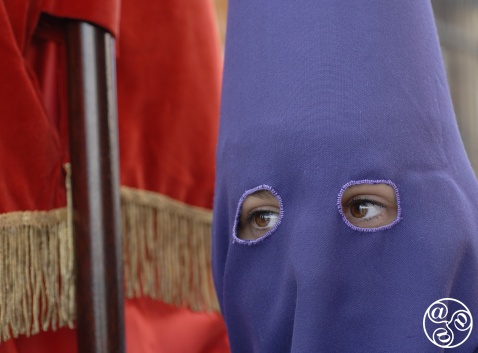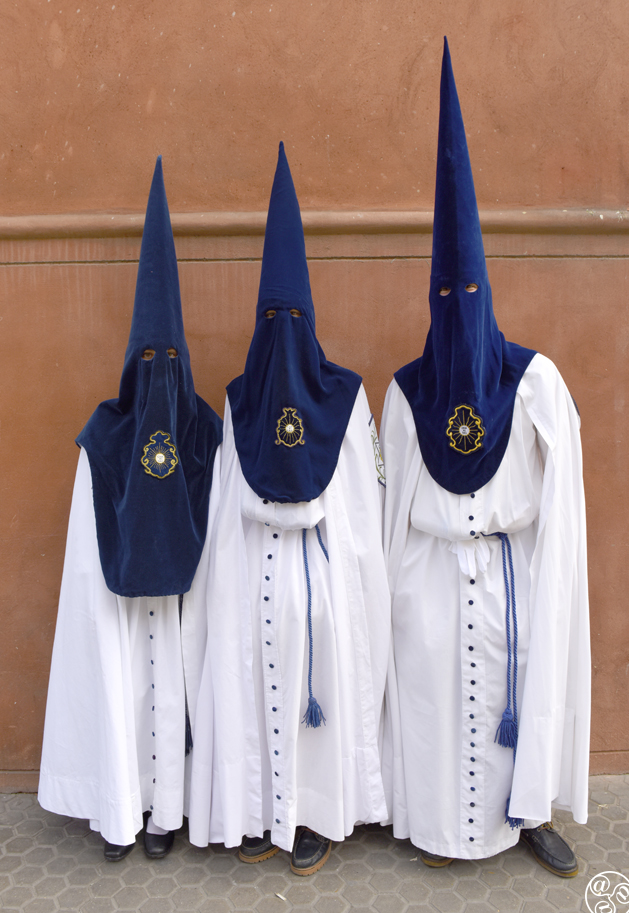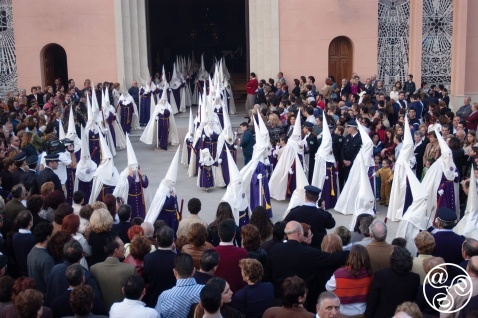
Hermandad del Santisimo Cristo de los Remedios Y Nuestra Senora de Las Angustias Semana Santa Vienes Santo Holy week Processions in Andalucia. |
|
The Nazarenes
Guide to Holy Week / Semana Santa in Andalucia
Semana Santa processions explained in detail
The “Nazarenos” are the members of the “cofradías” who participate in the processions. They are also known as the “penitentes” (penitent ones).
These are the people you see who are dressed in robes and capes, wearing cone shaped head gear that makes it impossible to know who is behind their disguises. It also reminds many foreigners of images of the Ku Klux Klan in the United States. However, these cone-shaped paraphernalia have no sinister significance and, in fact, their symbolic meaning is actually quite interesting.
The Nazarenos, a prominent feature of the Spanish Holy Week processions, embody deep symbolism and tradition. These penitents wear distinctive robes, often hooded, reminiscent of medieval brotherhoods, creating an aura of mystery and solemnity. Their attire, usually in sombre colours such as black or purple, symbolises mourning and repentance, reflecting the gravity of Christ's passion and death.
Walking in solemn procession, the Nazarenos carry symbols of their faith, such as crosses or candles, as they make their pilgrimage through the streets. Their slow and deliberate steps evoke a sense of humility and penitence, inviting contemplation and reflection from onlookers. The rhythmic sound of their footsteps, often accompanied by sombre music, creates an atmosphere of emotion within the bustling crowds.

The symbol of the cone
According to an article in Spanish at Wikipedia (there are some very passionate Spaniards involved in the Semana Santa section of the site), the cone is supposed to symbolise a sort of rising towards the heavens and therefore this part of the Nazarenes’ dress is designed to bring their penitence closer to the heavens. It is also noted that in the same way, cone shaped shrubs, such as cypress trees, are used in Spanish cemeteries – to symbolically raise the dead towards the heavens.
The female Nazarenes
There has been quite a debate over whether or not women can take on the traditional role of Nazarene, but it is now more and more common. Our Wikipedia source also indicates that women have probably been participating over the years without anyone knowing – as their identity is so disguised. Years ago, it seems there have always been whispers that this or that Nazarene is actually female, nowadays there are more and more women taking part in the semana santa processions, such as the town of Luque in Cordoba on Easter Saturday. In Ronda on Easter Sunday the paso of the Virgin Mary is the only one in Ronda carried by women. In Estepona one of the five floats in Good Friday's Veracruz prossesion is carried by women.
Watching the processions
For spectators, witnessing the Nazarenos in procession can be a deeply moving experience, stirring the soul and fostering a sense of spiritual connection. Their presence is a poignant reminder of the enduring traditions and deep faith that characterise Holy Week in Andalucia making it a time of both solemnity and reflection.
Beyond their symbolic dress and procession, the Nazarenos represent a diverse cross-section of society, coming together in a common expression of faith and devotion. Regardless of background or status, they are united in their commitment to honour the religious significance of Holy Week.
for the non-religious observer
Even for the non-religious observer, the meticulous planning and seamless coordination evident in Holy Week processions across Andalusia are undeniably impressive. From the intricate choreography of the Nazarenos' movements to the elaborate decorations adorning the streets, it's a testament to the dedication and craftsmanship of the brother and sisterhoods. The fusion of tradition, artistry, and collective effort creates a spectacle that transcends religious boundaries, captivating hearts and minds alike.
Semana Santa dates
Semana Santa dates for the next few years are in the info box on our Semana Santa home page
Guide to Holy Week / Semana Santa in Andalucia
Semana Santa processions explained in detail
